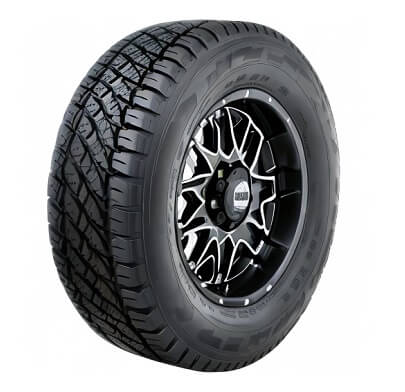245 vs 275 Tires

The main difference between 245 and 275 tires is the width. The 245 tire is typically 30 millimeters narrower than a 275 tire. The larger tire provides more contact with the road, more grip around turns, and an improved look for your vehicle.
245 vs 275 Table
Get a quick overview of the differences between 245 and 275 tire sizes with our handy comparison table.
| Tire Size 245 | Tire Size 275 |
|---|---|
| Compared to 275 tires, 245 tires deliver a smoother riding experience. | Optimal traction on dry surfaces, 275 tires are a better option than 245 tires. |
| Opting for 245 tires is generally more cost-effective than purchasing 275 tires. | Enhanced handling performance is offered by 275 tires in comparison to 245 tires. |
| In wet, snowy, and slushy conditions, 245 tires typically provide superior traction over 275 tires. | When carrying heavier loads, opting for 275 tires is preferable over 245 tires. |
| Better fuel efficiency is achievable with 245 tires as opposed to 275 tires. | In terms of visual appeal, 275 tires generally surpass 245 tires. |
| For a tire size of 245, the recommended rim width range is between 7 to 8.5 inches. | The recommended rim width range for a tire size of 275 is between 8 to 10 inches. |
| The 245 tire size is slightly smaller than the 275 tire size by 30 millimeters. | The 275 tire size is larger than the 235 tire size by 30 millimeters. |
| As both 245 and 275 tire sizes have a similar rim width range, 245 tires can serve as a viable replacement for 275 tires. | Since both 245 and 275 tire sizes have a similar range of rim widths, it’s possible to substitute 245 tires with 275 tires. |
Fuel Economy
When it comes to tires, size does matter. Regarding fuel economy, the 245 tire size stands out as a clear winner compared to the 275 tire size. The smaller 245 tire size is designed for better fuel efficiency, and it shows in the results.
It’s no surprise that when comparing two cars with identical engines and driving habits, the car with 245 tires will have significantly better gas mileage than its 275-tired counterpart.

Ride Comfort
“The proof is in the pudding,” as they say, and it’s no surprise that the 245 tire size offers a more comfortable ride compared to 275 tires. The 245 tire size is more narrow, which means less surface area contacting the road at any given time.
Understanding tire sizes is crucial for an optimal driving experience. It’s worth noting that larger sidewalls can provide a smoother ride by effectively cushioning your vehicle from road irregularities. This results in a comfortable and more stable ride, allowing you to enjoy the journey confidently.
Load Capacity
Load capacity determines how much weight a vehicle can safely carry, including passengers and cargo. So, when comparing 245 and 275 tires, there are some key differences in load capacity. The first difference is that 275 tires typically have a higher load index than 245 tires.
This means they can carry more weight. For example, a 245/50R16 tire might have a load index of 94, while a 275/50R16 would likely have a load index of 97 or higher. This would give the 275 tires an extra 3% carrying capability over the 245 tires.
Wet & Snow Traction
When it comes to driving in wet and hazardous conditions, 245 tires are the way to go. They have a shallower tread pattern than 275 tires, which makes them better suited for traversing through snow, rain, and slush.
The 245 tire size provides higher pressure per square inch rating than the wider 275 tires, allowing them to exert more force and grip deeper into the road surface, providing excellent stability and control.

Dry Traction
The 275 tires offer superior traction on dry roads compared to the 245 tires due to their increased width. Their wider design gives them more contact with the surface of the road, providing superior grip in high-speed scenarios.
This makes them ideal for drivers who want maximum performance and control on dry roads. Their wider design also offers improved handling performance compared to 245 tires.
The additional width helps reduce understeer and oversteer when cornering, allowing you to confidently take tight corners. In addition, the 275 tires have a much larger footprint than 245, giving you extra stability when accelerating or braking hard.
Handling Performance
The 275 tires offer superior handling performance compared to the 245 tires. The larger size of the 275 tires provides for a broader contact patch with the road, resulting in better grip and improved cornering.
This allows for more precise cornering and improved acceleration, which can be especially beneficial when driving in inclement weather. Additionally, the increased tire width provides a more comfortable ride quality due to a softer suspension.

Can I Use 245 Tires Instead of 275
Yes, it is possible to use 245 tires instead of 275 tires. The ideal rim width ranges for these sizes overlap, with 245 tires fitting 7.5-9.0 inch rims and 275 tires fitting 8.5-10.0 inch rims.
Keep in mind that the aspect ratio and rim diameter of the new tires should match your current setup. If the aspect ratio or rim diameter does not match, the overall diameter difference should stay within 3% to avoid affecting speedometer accuracy and vehicle performance.
Can I Put 245 Tires on 275 Rims
Yes, you can put 245 tires on rims designed for 275 tires. The ideal rim width range for 275 tires (8.5-10.0 inches) overlaps with the range for 245 tires (7.5-9.0 inches), ensuring proper fitment and performance.
Difference Between 245 and 275 Tires
The main difference between 245 and 275 tires is the section width, with 275 tires being 30mm wider than 245 tires. This difference in width affects various performance aspects, such as traction, handling, and overall vehicle dynamics.

Can I Use 275 Tires Instead of 245
Yes, it is possible to use 275 tires instead of 245 tires. The ideal rim width ranges for these sizes overlap, making the switch feasible. However, consider the aspect ratio and rim diameter to ensure optimal performance and speedometer accuracy.
To ensure your vehicle performs at its best and maintains accurate speedometer readings, prioritize new tires with an aspect ratio and rim diameter that are consistent with your existing configuration. If a perfect match is not possible, ensure the overall diameter difference stays within 3%.
Can I Put 275 Tires on 245 Rims
Yes, you can put 275 tires on rims designed for 245 tires. The ideal rim width range for 245 tires (7.5-9.0 inches) overlaps with the range for 275 tires (8.5-10.0 inches), ensuring proper fitment and performance.
Conclusion
For instance, the 245 tire size offers improved fuel economy and comfort while providing better traction in slippery conditions such as snow or rain.
On the other hand, the 275 tire provides superior handling performance and is better suited for carrying heavier loads. However, those looking for maximum traction on dry roads may find the wider profile of the 275 tires is more suitable.

Meet Caitlin McCormack, a Tire Size Expert and Blogger Passionate About Everything Related to Tires. With Years of Experience in the Tire Industry, Caitlin Has Become an Expert in Tire Sizes and Their Impact on Vehicle Performance.
